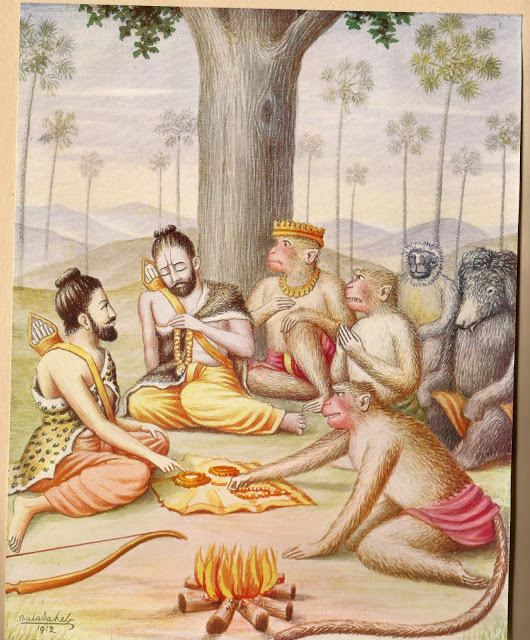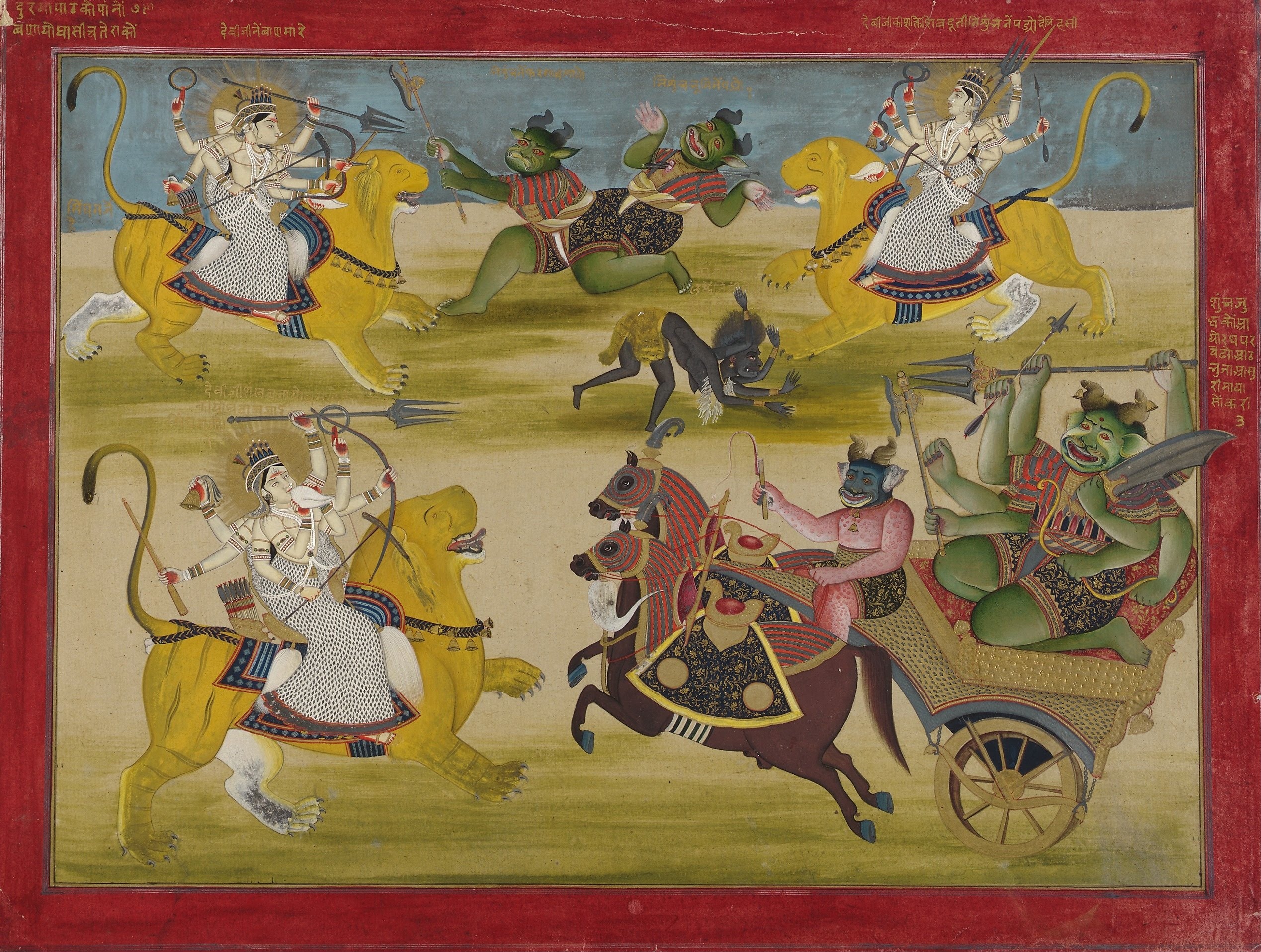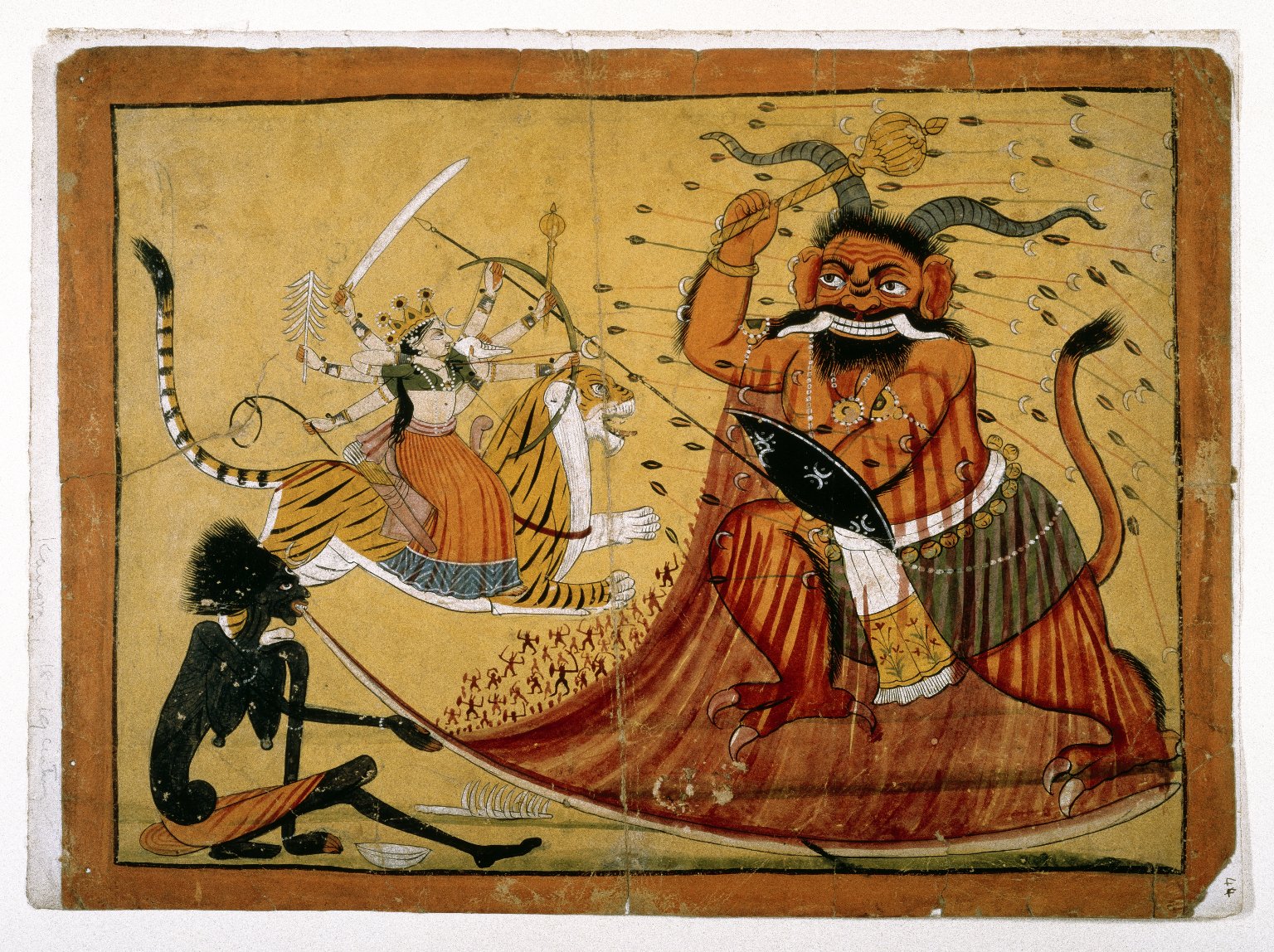|
Rambha (asura)
Rambha is an asura in Hindu mythology. Rambha and Karambha are asura brothers, born as the descendants of Danu and Kashyapa. When they were young, both decided to perform penance to get special powers to establish the rule of Danavas in the universe. Penance and boon Rambha started penance standing inside a burning fire to please Agni Deva, while Karambha stood inside water to please Varuna Deva. When Indra became aware, he decided to kill both brothers. Firstly, Indra assumed the form of a makara and dragged Karambha into the depths, drowning him. However, Agni Deva saved Rambha when Indra tried to kill him. Finally, Rambha got a boon from Agni Deva that he would not be killed by any Deity (Deva), Demon ( Danava) or human. Only a dead man could kill him (which was virtually impossible). Rambha became powerful after getting the boon; he began mass killings of human beings and other living beings. Birth of Mahishasura Afterward, Rambha saw a water buffalo and fell in love with h ... [...More Info...] [...Related Items...] OR: [Wikipedia] [Google] [Baidu] |
Asura
Asuras (Sanskrit: असुर) are a class of beings in Indian religions, Indic religions. They are described as power-seeking clans related to the more benevolent Deva (Hinduism), Devas (also known as Suras) in Hinduism. In its Buddhism, Buddhist context, the word is sometimes translated "Titan (mythology), titan", "demigod", or "antigod". According to Hindu texts, Hindu scriptures, the asuras are in constant battle with the devas. Asuras are described in Indian texts as powerful superhuman demigods with good or bad qualities. In early Vedic literature, the good Asuras are called ''Adityas'' and are led by Varuna, while the malevolent ones are called ''Danava (Hinduism), Danavas'' and are led by Vritra. In the earliest layer of Vedic texts Agni, Indra and other gods are also called Asuras, in the sense of their being "lords" of their respective domains, knowledge and abilities. In later Vedic and post-Vedic texts, the benevolent gods are call ... [...More Info...] [...Related Items...] OR: [Wikipedia] [Google] [Baidu] |
Rishi
''Rishi'' () is a term for an accomplished and enlightened person. They find mentions in various Vedic texts. Rishis are believed to have composed hymns of the Vedas. The Post-Vedic tradition of Hinduism regards the rishis as "great yogis" or "sages" who after intense meditation (tapas) realized the supreme truth and eternal knowledge, which they composed into hymns.Hartmut Scharfe (2002), Handbook of Oriental Studies, BRILL Academic, , pp. 13–15. The term appears in Pali literature as Ishi and in Buddhism, they can be either Buddhas, Paccekabuddhas, Arahats or a monk of high rank. Etymology According to Indian tradition, the word may be derived from two different meanings of the root 'rsh' (). Sanskrit grammarians derive this word from the second meaning: "to go, to move". V. S. Apte gives this particular meaning and derivation, and Monier-Williams also gives the same, with some qualification. Another form of this root means "to flow, to move near by flowing". (All the ... [...More Info...] [...Related Items...] OR: [Wikipedia] [Google] [Baidu] |
Divine Life Society
The Divine Life Society (DLS) is a Hindu spiritual organisation and an ashram, founded by Swami Sivananda Saraswati in 1936, at Muni Ki Reti, Rishikesh, India. Today it has branches around the world, the headquarters being situated in Rishikesh. Also, many disciples of Swami Sivananda have started independent organisations in Mauritius, the US, Australia, Canada, Malaysia, South Africa, South America, and Europe. Aims Its aim is to disseminate spiritual knowledge in the following ways: * through publication of books, pamphlets and magazines on the subjects of Yoga and Vedanta * holding and arranging spiritual conferences and discourses (Satsang) * establishing training centers for the practice of Yoga * enabling aspirants to develop their spiritual lives via systematic training in yoga and philosophy * establishing charitable organisations * through the preservation of the ancient traditions and cultural practices of India History In 1936, after returning from a pilgrimage, ... [...More Info...] [...Related Items...] OR: [Wikipedia] [Google] [Baidu] |
Swami Sivananda
Sivananda Saraswati (or Swami Sivananda; 8 September 1887 – 14 July 1963) was a yoga guru, a Hindu spiritual teacher, and a proponent of Vedanta. Sivananda was born Kuppuswami in Pattamadai, in the Tirunelveli district of Tamil Nadu. He studied medicine and served in British Malaya as a physician for several years before taking up monasticism. He was the founder of the Divine Life Society (DLS) in 1936, Yoga-Vedanta Forest Academy (1948) and author of over 200 books on yoga, Vedanta, and a variety of subjects. He established Sivananda Ashram, the headquarters of the DLS, on the bank of the Ganges at Muni Ki Reti, from Rishikesh, and lived most of his life there. Sivananda Yoga, the yoga form propagated by his disciple Vishnudevananda, is now spread in many parts of the world through Sivananda Yoga Vedanta Centres. These centres are not affiliated with Sivananda's ashrams, which are run by the Divine Life Society. Biography Early life Swami Sivananda was born as Ku ... [...More Info...] [...Related Items...] OR: [Wikipedia] [Google] [Baidu] |
Sugriva (asura)
''This character is about the vanara, in the Ramayana.'' Sugriva ( sa, सुग्रीव, , ) is a character In the ancient Indian epic Ramayana. He is the younger brother of Vali, whom he succeeded as ruler of the vanara kingdom of Kishkindha. Rumā is his wife. He is a son of Surya, the Hindu deity of the sun. As the king of the vanaras, Sugriva aided Rama in his quest to liberate his wife Sita from captivity at the hands of the rakshasa king Ravana. Nomenclature He is also known as jv, Sugriwa, th, Su-khrip, lo, Sugeep, km, Sukhreeb, Creole: ''Soogrim'', lo, Sangkip, ta, Cukkirivan, my, Thugyeik, Sugreeva or Sugreev. Legend The story of Sugriva is part of Ramayana and in an abbreviated version, is also present in the Mahabharata. The king of Kishkindha, Vrikshraja, was a divine creature born from Brahma's tilaka. He had the body of a human and face and tail of a monkey. He was instructed to roam the forests and kill demons. One day, Vriksharaja entered an ... [...More Info...] [...Related Items...] OR: [Wikipedia] [Google] [Baidu] |
Chanda And Munda
In Hinduism, in the Devi Mahatmya, Chanda and Munda are asuras (demons) in the service of Sumbha and Nishumbha. After the death of Dhumralochana, Sumbha sent them to fight Devi Kaushiki. After Chanda and Munda approached Devi Kaushiki, she turned black and Kali sprung from her head and killed them. Then, Kaushiki gave the name Chamunda to Kali. Afterward Raktabīja was sent, but was also slain by Goddess Kali. See also * Rambha (asura) * Raktabīja * Sumbha and Nisumbha * Mahishasura Mahishasura is a bovine asura in Hinduism. He is depicted in literature to be a deceitful demon who pursued his evil ways by shape-shifting. Mahishasura was the son of Mahisi (Buffalo) and the great-grandson of Brahmarshi Kashyapa. He was ultim ... * Dhumralochana * Sugriva (asura) References Danavas {{Hindu-myth-stub ... [...More Info...] [...Related Items...] OR: [Wikipedia] [Google] [Baidu] |
Kaushiki
Kaushiki ( sa, कौशिकी, lit=woman of the cell, translit=Kauśikī,) is a Hindu goddess, a deity who emerged from the sheath of Parvati. She was created before Parvati's conflict with the asura brothers Sumbha and Nisumbha, and was also the reason the Matrikas come into existence. According to the Lakshmi Tantra, Kaushiki is a manifestation of the goddess Lakshmi. Legends Puranas The story of Kaushiki is described in Devi Mahatmyam of Markandeya Purana. Devi Mahatmyam describes the goddess Kaushiki appearing from the sheath (or ''kosha'') of the goddess Parvati’s body when the devas sang her praises after their crushing defeat against the asuras Sumbha and Nisumbha. Their eulogies that were intended to be a plea for help caused her to manifest from Parvati's form as a fair-skinned and bright being, earning the epithet 'Gauri'. The fact that she had been created from the cells of Parvati caused her to name herself Kaushiki, literally meaning 'woman of the cell'. With th ... [...More Info...] [...Related Items...] OR: [Wikipedia] [Google] [Baidu] |
Sumbha And Nisumbha
In the Devi Mahatmya, Sumbha (शुम्भ) and Nisumbha (निशुम्भ), were two '' asuras'' that confronted, and were ultimately slain by Kaushiki; an avatar of Devi Chandi. In the Devi Mahatmyam The story of Sumbha and Nisumbha begins in the fifth chapter of the Devi Mahatmyam. Parvati relates how two brothers of Asura stock sought to conquer the Three Worlds by subjecting themselves to severe penance and purification rituals so that no man or demon could destroy them. Sumbha and Nisumbha traveled to Pushkara, a sacred place, and remained there in prayer for ten thousand years. God Brahma saw the brothers' penance, and was pleased, granting them the boon they requested. It was at this time that Chanda and Munda, two lesser Asuras in the service of Shumbha, encountered Parvati, and were overwhelmed by her beauty. They carried reports of this goddess to Shumbha, who sought to possess Parvati and her beauty. Shumbha sent the demon Sugriva (asura) to court Parvati, b ... [...More Info...] [...Related Items...] OR: [Wikipedia] [Google] [Baidu] |
Raktabīja
Raktabija () is an asura in Hinduism. According to the Puranas, he fought with Sumbha and Nisumbha against the goddesses Kali and Chandi, both forms of Durga. Raktabija had acquired a boon from Shiva that whenever a drop of his blood fell on the ground, various Raktabijas would emerge from the spot, equivalent to his strength, form, and weapons. Legend Origin According to the Puranas, Raktabija was, in his previous birth, Rambha, the son of Danu, the king of the asuras. Due to being childless, Rambha and his brother, Karambha, performed a penance to seek offspring. The brothers performed a tapas, with Rambha seated in the midst of five fires, and Karambha in the midst of water. Alarmed, Indra assumed the form of a makara and dragged Karambha into the depths, drowning him. Enraged, Rambha decided to offer his own head to the fires as a sacrifice. Agni appeared before him, and urged him to desist from performing suicide, denouncing it as a great sin. He offered Rambha a b ... [...More Info...] [...Related Items...] OR: [Wikipedia] [Google] [Baidu] |
Dadhichi
Dadhichi (), also rendered Dadhyanga and Dadhyancha, is a sage in Hinduism. He is best known for his sacrifice in the Puranas, where he gives up his life so that his bones could be used to manufacture the Vajra, the diamond-like celestial thunderbolt of the deity Indra, in order to slay Vritra. Literature In the Bhagavata Purana, Dadhichi is described as the son of the sage Atharvan and his wife, Chitti. Atharvan is said to be the author of Atharvaveda, which is one of the four Vedas. Chitti was the daughter of the sage Kardama. The names of Dadhichi's wife and son were Suvarcas and Pippalada, respectively. After the death of Dadhichi, when Suvarcas was about to ascend the funeral pyre, she heard an ''aśarīriṇī vāṇī'' (a celestial voice) that informed her that she was pregnant. Suvarcas removed the foetus from her womb with a stone, and placed it near a banyan tree, proceeding to end her life. Her child, Pippalada, became a famous rishi, associated with the Pippal ... [...More Info...] [...Related Items...] OR: [Wikipedia] [Google] [Baidu] |
Vajra
The Vajra () is a legendary and ritual weapon, symbolising the properties of a diamond (indestructibility) and a thunderbolt (irresistible force). The vajra is a type of club with a ribbed spherical head. The ribs may meet in a ball-shaped top, or they may be separate and end in sharp points with which to stab. The vajra is the weapon of Indra, the Vedic king of the devas and heaven. It is used symbolically by the dharmic traditions of Hinduism, Buddhism, and Jainism, often to represent firmness of spirit and spiritual power. According to Hinduism, the vajra is considered one of the most powerful weapons in the universe. The use of the vajra as a symbolic and ritual tool spread from Hinduism to other religions in India and other parts of Asia. Etymology According to Asko Parpola, the Sanskrit () and Avestan both refer to a weapon of the Godhead, and are possibly from the Proto-Indo-European root ''*weg'-'' which means "to be(come) powerful". It is related to Proto- ... [...More Info...] [...Related Items...] OR: [Wikipedia] [Google] [Baidu] |









